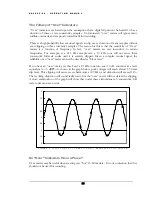
A D 2 4 0 2 - 9 6 - O P E R A T I N G M A N U A L
The only way to achieve a low noise level with the preamplifier is to use extremely low internal
impedances and ultra low-noise operational amplifiers. Both of these required techniques are
power hungry and incompatible with portable pre-amps where long battery life is an objective.
Therefore, avoid microphone preamps that cannot achieve at least +16 dBu out, without clipping.
Even then the dynamic range of the preamp and not the AD2402-96 will, in all probability, be
limiting the dynamic range of your high-quality 24-bit recordings.
“Lock” LED
The “LOCK” LED will turn on whenever the AD2402-96 is locked to a reliable digital audio
reference of the correct frequency. The digital input/reference signal must be AES/EBU or
SPDIF.
The AD2402-96 will lock at 1:1 or 2:1 ratios.
For example, if the AD2402-96 is operating at 96
kHz, the converter will lock to either a 48 kHz or 96 kHz digital audio signal.
If the lock light is off, the AD2402-96 is operating as clock master (using the internal crystal
reference).
Important Note:
An external reference is normally not required for 2-channel recording. The lock
LED will
not
be on when the
AD2402-96
is operating as a stand-alone (clock
master) device. This is not an indicator of an error.
A digital audio input is required in the “Var” (variable sample rate) and “D-to-D” (digital to
digital) modes. It is optional in all other modes.
When locking to an external reference, the “Lock” LED will flash for several seconds while
the PLL is acquiring lock and will be lit once internal lock is achieved.
A continuously flashing “Lock” light indicates a lock error.
Possible causes of a lock error include:
•
Reference sample frequency is incorrect or out of range.
•
Reference signal is neither AES/EBU nor SPDIF.
•
Reference signal is being received with errors.
•
Reference is required (“Var” and “D-to-D” modes) but is not present.
12













































